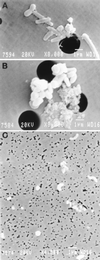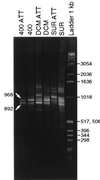Diversity of free-living and attached bacteria in offshore Western Mediterranean waters as depicted by analysis of genes encoding 16S rRNA
- PMID: 9925576
- PMCID: PMC91055
- DOI: 10.1128/AEM.65.2.514-522.1999
Diversity of free-living and attached bacteria in offshore Western Mediterranean waters as depicted by analysis of genes encoding 16S rRNA
Abstract
In a previous study (S. G. Acinas, F. Rodríguez-Valera, and C. Pedrós-Alió, FEMS Microbiol. Ecol. 24:27-40, 1997), community fingerprinting by 16S rDNA restriction analysis applied to Mediterranean offshore waters showed that the free-living pelagic bacterial community was very different from the bacterial cells aggregated or attached to particles of more than about 8 micrometer. Here we have studied both assemblages at three depths (5, 50, and 400 m) by cloning and sequencing the 16S rDNA obtained from the same samples, and we have also studied the samples by scanning electron microscopy to detect morphology patterns. As expected, the sequences retrieved from the assemblages were very different. The subsample of attached bacteria contained very little diversity, with close relatives of a well-known species of marine bacteria, Alteromonas macleodii, representing the vast majority of the clones at every depth. On the other hand, the free-living assemblage was highly diverse and varied with depth. At 400 m, close relatives of cultivated gamma Proteobacteria predominated, but as shown by other authors, near the surface most clones were related to phylotypes described only by sequence, in which the alpha Proteobacteria of the SAR11 cluster predominated. The new technique of rDNA internal spacer analysis has been utilized, confirming these results. Clones representative of the A. macleodii cluster have been completely sequenced, producing a picture that fits well with the idea that they could represent a genus with at least two species and with a characteristic depth distribution.
Figures



References
-
- Acinas S G, Rodríguez-Valera F, Pedrós-Alió C. Spatial and temporal variation in marine bacterioplankton diversity as shown by RFLP fingerprinting of PCR amplified 16S rDNA. FEMS Microbiol Ecol. 1997;24:27–40.
-
- Alldredge A L, Cole J J, Caron D A. Production of heterotrophic bacteria inhabiting macroscopic organic aggregates (marine snow) from surface waters. Limnol Oceanogr. 1986;31:68–78.
Publication types
MeSH terms
Substances
Associated data
- Actions
- Actions
- Actions
- Actions
- Actions
- Actions
- Actions
- Actions
- Actions
- Actions
- Actions
- Actions
- Actions
- Actions
- Actions
- Actions
- Actions
- Actions
- Actions
- Actions
- Actions
- Actions
- Actions
- Actions
- Actions
- Actions
- Actions
- Actions
- Actions
- Actions
LinkOut - more resources
Full Text Sources
Molecular Biology Databases
Research Materials

